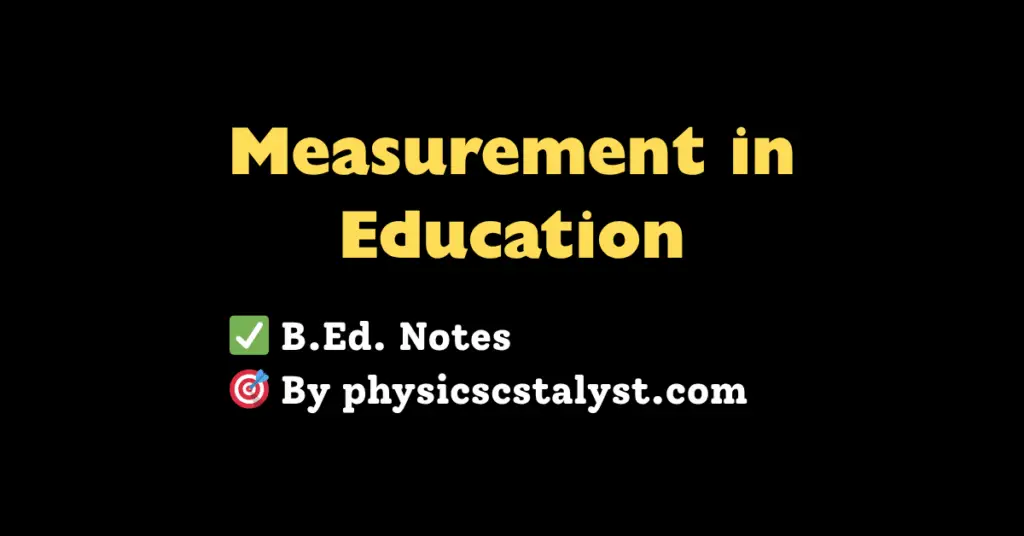Measurement is a foundational concept for teachers and educators, particularly for B.Ed. students preparing to effectively understand and guide the learning process. This article presents a clear, step-by-step explanation of measurement in education, covering its meaning, types, examples, characteristics, and importance.
Concept of Measurement in Education
- Measurement forms the foundation for assessment and evaluation in education.
- It quantifies learning outcomes and psychological attributes making them measurable and comparable.
- Educators use measurement tools such as tests, quizzes, observations, and rating scales to collect data.
- The ultimate aim is not just to measure but to use this data to improve learning and teaching.
- Measurement processes face challenges like ensuring fairness, reliability, and validity.
Measurement Definition in Education
- According to educationists, measurement is “the process of assigning numbers or symbols to attributes according to specific rules.“
- It is systematic, standardized, and objective; converting qualitative traits into quantitative data for analysis.
- Measurement is essential for diagnosing student abilities, predicting future performance, and classifying students.
Measurement in Education Meaning
- Measurement in education is the process of assigning numerical values or symbols to the traits, behaviors, or performance of students according to defined rules and scales.
- It involves quantifying aspects like intelligence, achievement, skills, or attitudes to make them observable and comparable.
- Fundamentally, it turns abstract qualities into numbers that can be analyzed objectively.
Types of Measurement in Education
Educational measurement can be categorized based on the scale or method:
- Nominal Measurement: Categorizes data without order — e.g., classifying students by gender.
- Ordinal Measurement: Ranks data in order but intervals are not equal — e.g., ranking students first, second, third.
- Interval Measurement: Measures data with equal intervals but no true zero — e.g., temperature scales.
- Ratio Measurement: Includes a true zero point allowing ratios — e.g., number of correct answers.
Additionally, educational measurements may be:
- Formative: Ongoing measurements to guide learning.
- Summative: Final measurements at the end of instruction.
Example of Measurement in Education
- A student scores 80 out of 100 on a mathematics test. This “80” is the measurement – a numerical representation of performance.
- Another example is measuring intelligence through IQ tests, where a numerical IQ score is assigned.
- Measuring attendance as the number of days present also falls under measurement.
Measurement and Evaluation in Education
- While measurement provides raw scores or numerical data, evaluation is a broader judgment process that interprets measurement data to make decisions about learning effectiveness.
- Measurement focuses on “how much” or “how well” something is done; evaluation focuses on the value or quality of that performance.
- In education, teachers use measurement to collect data and then evaluation to determine teaching success or student achievement.
Characteristics of Measurement in Education
- No absolute zero: A zero score does not mean absence of knowledge, just lowest measured performance.
- Symbol assignment: Measurement assigns symbols or numbers that represent observed traits.
- Relative and comparative: Scores are interpreted relative to standards or groups.
- Indirect: Measures are based on behavior or performance, not the traits themselves.
- Continuous process: Measurement is ongoing, helping in monitoring progress.
- Objective: Involves rules that minimize subjective judgment.
Importance of Measurements in Education
- Diagnosis: Identifies student strengths and weaknesses.
- Classification: Groups students based on ability or achievement levels.
- Prediction: Helps predict future academic performance.
- Evaluation of Instruction: Provides data on the effectiveness of teaching methods.
- Benchmarking: Facilitates comparison among different groups or over time.
- Guides curriculum development and instructional planning based on measurable outcomes.
Conclusion
Measurement in education transforms complex human traits into quantifiable data using systematic procedures. This process is essential for effective teaching, learning evaluation, and educational improvement. Mastery of this concept equips B.Ed. students and teachers with crucial tools to support their students’ academic journeys.

